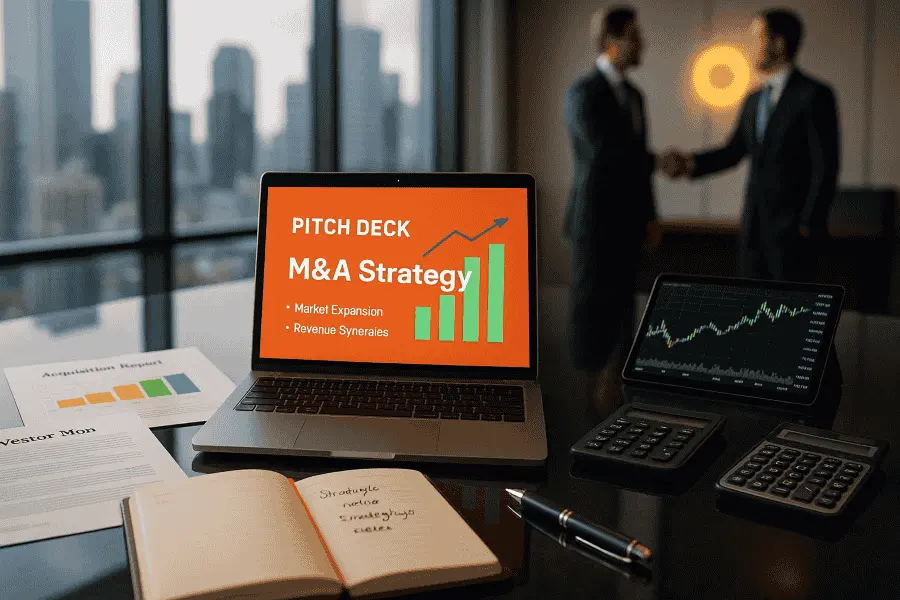Capital abundance, market saturation, and aggressive strategic behavior have amplified competition. Investors looking to outmaneuver rivals must employ nuanced strategies, thoughtful planning, and calculated execution. To win in competitive acquisition markets, investors must master three fundamental strategic pillars: swift and precise deal execution, strategic differentiation, and superior relationship management.
This blog explores the most effective tactics that successful investors deploy to outmaneuver rivals, seize high-value assets, and build enduring portfolios, even when competition is fierce.
Understanding the Dynamics of Competitive Acquisition Markets
Acquisition markets become competitive primarily due to scarcity and opportunity. Whether it's a groundbreaking tech startup or a rapidly growing SaaS platform, assets with significant market potential naturally attract competition. Investors who thrive recognize these competitive dynamics early:
- Demand far exceeds supply: Valuable opportunities attract large pools of capital, causing valuations to inflate.
- Rapid due diligence: Investors have shorter windows for diligence, requiring quicker decision-making with greater confidence.
- Relationship leverage: Success often hinges on established trust networks and prior relationships.
The first rule of winning is knowing precisely what you're up against and how to position yourself effectively. Your detailed exploration of market mapping naturally complements the insights found in startup acquisition strategies, providing a broader framework.
Strategic Foundations for Competitive Acquisition Success
Strategic Foundations for Acquisition Success
Pillar 1: Swift and Precise Deal Execution
In competitive acquisition markets, speed matters. However, speed alone isn't enough—precision is equally critical. Swift and precise execution hinges on rapid opportunity assessment, structured diligence, and optimized decision-making.
Rapid Opportunity Assessment
Effective investors move quickly from identifying opportunities to making initial assessments. Due diligence often takes time, but preliminary screening must happen fast. An initial framework helps swiftly identify deals worth pursuing. For instance, creating a standardized preliminary scoring system based on predefined criteria, such as industry growth rates, profitability metrics, and operational synergies—enables teams to assess quickly and objectively.
Investors must also build specialized rapid-response teams. These small, cross-functional groups evaluate potential acquisitions, providing a streamlined and efficient approach to determining which deals deserve deeper scrutiny. The use of AI-driven analytics to rapidly scan market data can further speed this assessment, flagging valuable targets even before competitors become aware of them.
Structured Due Diligence
Precision requires structured due diligence. The goal is to uncover deal-breaking risks early. The due diligence process should be customized yet systematic. Investors often underestimate the importance of tailoring diligence frameworks for different sectors and deal sizes. A one-size-fits-all approach is ineffective because each acquisition carries distinct risks and complexities.
Consider a technology acquisition versus a manufacturing business purchase. For tech companies, diligence might focus heavily on intellectual property, technological scalability, and talent retention. In contrast, manufacturing acquisitions require careful assessments of physical assets, inventory quality, supply chain vulnerabilities, and production efficiency. Clearly delineated processes for each sector can improve the accuracy and depth of evaluations, reducing surprises later.
Optimized Decision-Making
Decision-making efficiency sets top-performing investors apart. Successful firms establish clear, data-driven decision points and thresholds for moving forward. The purpose is to avoid internal delays that can derail acquisition timelines and provide openings for competitors.
Investors should leverage structured frameworks—such as decision trees or weighted scoring models—to guide their decision-making. Assigning clear roles and authority for decisions within deal teams also improves speed and efficiency. The fewer the layers required to approve a transaction, the greater the speed and clarity of the execution process.
Moreover, leveraging digital tools like virtual deal rooms and collaborative software solutions ensures all stakeholders can rapidly access critical documents and share insights in real-time, enhancing speed without sacrificing thoroughness. Subtle differences emerge when you compare these mapping techniques with startup acquisition vs partnership, offering clarity on how investors weigh acquisition decisions alongside potential partnerships
Pillar 2: Strategic Differentiation
In competitive acquisition markets, standing out from the crowd is crucial. Investors cannot rely solely on financial firepower. Strategic differentiation offers a pathway for investors to consistently outbid and outperform competitors, often without needing to pay the highest price.
Clear Value Proposition
Winning investors define a clear, compelling value proposition beyond simply price. They articulate how their ownership will uniquely add value to the target. Perhaps they have specialized industry expertise, exclusive technology partnerships, superior operational practices, or market access that competitors lack. Investors who communicate these unique advantages convincingly improve their chances of acquisition success.
For instance, an investor with extensive expertise in digital transformation could appeal to legacy companies looking to modernize operations. By clearly articulating their capabilities and track record in executing digital transformations, the investor stands out from purely financial bidders.
Creative Deal Structuring
Investors can also differentiate through creative and customized deal structures. Flexible transaction terms, such as earnouts, equity rollovers, and contingent payments, often help bridge valuation gaps. These creative structures not only mitigate upfront risk but also align interests between buyers and sellers, encouraging cooperative relationships post-acquisition.
For example, offering an earnout can persuade a hesitant seller who believes their business will achieve significant growth post-acquisition. The seller receives additional payments only if performance targets are met, giving both parties an incentive to maximize post-deal success. Such creativity can tip the scales in the investor's favor even when their initial bid isn't the highest.
Proactive Industry Insights
Investors who differentiate successfully often lead with proactive industry insights. Instead of reacting passively to market shifts, they leverage extensive market intelligence and trend analysis to anticipate future acquisition opportunities.
Deep sector-specific knowledge allows investors to foresee consolidation trends, disruptive innovations, or shifting regulatory landscapes. Proactive investors might target businesses poised to benefit from emerging technological shifts, regulatory changes, or evolving consumer preferences. Such strategic foresight positions these investors ahead of reactive competitors, allowing them to secure assets early in an opportunity's lifecycle—often at lower valuations.
Pillar 3: Superior Relationship Management
At its core, acquisition success is deeply relational. Investors who consistently outperform peers cultivate relationships strategically. They build strong, trust-based networks, enabling them to access off-market opportunities, gain competitive intelligence, and mobilize industry allies.
Trust-Based Networking
Relationship-building must be proactive, not reactive. Investors who systematically cultivate industry connections, including potential acquisition targets, industry consultants, bankers, and even competitors, gain vital early market insights.
For example, attending industry conferences, speaking engagements, and networking events consistently establishes investor presence and builds reputation. Offering insights and expertise proactively—such as sharing industry trend analyses or strategic white papers—can position investors as trusted industry thought leaders. This visibility and trust often open doors to exclusive off-market deal opportunities before competitors have a chance to engage.
Intermediaries
Building relationships with key intermediaries—such as investment banks, law firms, accounting firms, and industry advisors, is crucial. These intermediaries often control the flow of market intelligence and acquisition opportunities. Investors who maintain close, collaborative relationships with these gatekeepers often gain early notice of impending transactions.
Furthermore, clearly communicating the investor's acquisition criteria and strategic goals to intermediaries improves deal flow quality. Intermediaries are more likely to present targeted, high-quality acquisition opportunities when they clearly understand an investor's strategic focus and value-add potential.
Long-Term Seller Relationships
Investors sometimes overlook the importance of maintaining long-term relationships with previous sellers. Post-acquisition management significantly influences an investor's reputation, impacting future acquisition prospects.
Treating sellers fairly, transparently, and respectfully, even post-deal closure, builds investor goodwill. Positive seller experiences encourage sellers to recommend investors to peers and industry networks. This word-of-mouth recommendation can significantly enhance deal sourcing, providing a competitive edge.
Case Study: Winning Against Larger Competitors
Consider an emerging investor who successfully outbid a larger competitor for a high-growth tech startup:
- They leveraged a strong relationship with the founder built over several years.
- Quickly conducted effective diligence, confidently moving faster than the larger competitor’s cumbersome internal approval processes.
- Structured a compelling earn-out agreement aligning incentives with founder vision and delivered a comprehensive integration plan to ensure operational continuity.
- They employed strategic communication to highlight their track record of successful integration, alleviating founder fears about post-acquisition disruptions.
Despite having fewer resources, their agility, strategic discipline, and psychological astuteness ultimately secured the deal.
Practical Checklist for Investors
Before You Enter a Competitive Acquisition:
- Clearly define your investment thesis and value proposition.
- Establish rapid-response deal teams and delegate authority for quick decisions.
- Develop sector-specific due diligence checklists.
- Strengthen relationships with key industry intermediaries.
During the Process:
- Communicate your differentiators and deal flexibility proactively to the target.
- Leverage data analytics and market intelligence tools for real-time decision-making.
- Maintain financial discipline and avoid bidding wars.
- Ensure open, respectful engagement with sellers and advisors.
After the Deal:
- Execute a robust integration plan with clear milestones and owner accountability.
- Maintain transparent communication with the seller and key management.
- Monitor and measure synergies, reporting progress to stakeholders.
A clear timeline for executing strategies is provided when addressing the planning startup acquisition timeline, which aligns with the methodical approach discussed in this guide.
Tools & Resources for Competitive Acquisitions
- Virtual Data Rooms (VDR): Facilitate secure due diligence and document sharing (examples: Intralinks, Firmex)
- AI-Powered Market Intelligence: Platforms like PitchBook, S&P Capital IQ, or CB Insights help identify emerging targets and trends.
- Collaboration Software: Asana, Slack, and Microsoft Teams streamline internal communications and deal workflow.
- Third-Party Due Diligence Providers: Engage legal, financial, and operational experts tailored to each deal’s specifics.
Common Pitfalls: What to Avoid at All Costs
Even seasoned investors occasionally falter under competitive pressure. Avoid these common pitfalls:
- Bidding emotionally: Maintain rigorous financial discipline. Never let competitive tensions drive poor decisions.
- Ignoring non-financial factors: Overlooking seller motivations and company culture can derail even financially attractive deals.
- Underestimating integration complexity: Failing to adequately plan post-acquisition integration can destroy deal value quickly.
Investors must remain vigilant to avoid these common, costly errors.
Looking Ahead: The Future of Competitive Acquisitions
The future will likely see acquisition markets becoming even more fiercely competitive:
- Emerging technologies (AI, blockchain, quantum computing) will continue drawing investor attention, inflating valuations and accelerating deal timelines.
- Regulatory shifts will likely reshape competitive landscapes, requiring adaptive legal strategies and regulatory expertise.
- ESG (environmental, social, governance) criteria will increasingly influence acquisition decisions, creating new dynamics investors must navigate intelligently.
Forward-looking investors will continually adapt strategies, embracing emerging tools and predictive capabilities, positioning themselves well ahead of slower competitors. For further insights into aligning target evaluations with fund objectives, explore how to build an acquisition strategy. This resource connects evaluation criteria to broader strategic planning.
Conclusion
Winning consistently in competitive acquisition markets requires strategic clarity, tactical excellence, and nuanced psychology. Investors must remain disciplined in their valuation methodologies, nimble in their due diligence processes, and psychologically astute in negotiations.
Competitive acquisition success isn't merely about winning deals, it's about choosing the right ones, positioning oneself smartly, and driving sustainable value post-acquisition. By mastering these interconnected disciplines, investors position themselves not just to compete but consistently win.
If you're considering your next acquisition move, we at Qubit Capital are here to help with our Strategic Acquisition service. Connect with us to get started today!
Key Takeaways
- Speed matters in acquisitions, but only when paired with solid analysis.
- Winning deals often requires more than capital—value-add and expertise can tip the scales.
- Strong networks and trusted intermediaries unlock exclusive opportunities.
- Emotional bidding and weak integration planning are costly mistakes—discipline is critical.
- Agility is vital; strategies must evolve with new tech, regulations, and ESG demands.
Frequently asked Questions
What is the most important factor for winning in competitive acquisition markets—speed, price, or relationships?
All three are critical, but relationships often prove decisive. While speed can secure an edge and creative deal structuring can enhance offers, longstanding industry relationships frequently provide early access to deals and vital trust during negotiations.






